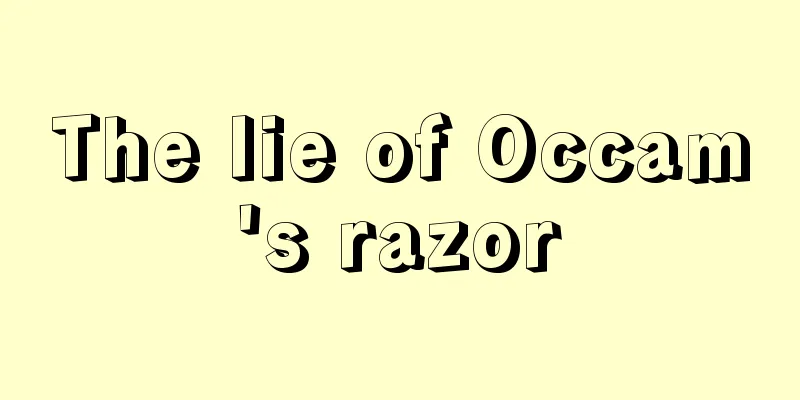The lie of Occam's razor

If we could go back in time, back to before Messi joined Inter Miami, please make a prediction. Scenario : Inter Miami has gone 9 games without a win. Question: After the football king Messi joins the team, which of the following is more likely? A. The team won in Messi's debut match. B. The team wins Messi's debut game and the home fans will collectively cheer the king's name. Would you choose A or B? I guess many people would choose B. But in fact, even though scenario B seems more plausible (and has occurred), scenario A is actually more likely. Because A includes the possibility of B, it is rational for you to predict that A is more likely. Nobel Prize winner Kahneman once designed a similar experiment. Most people chose the option that "seems more likely but is actually less likely." He called it the " conjunction fallacy ." Adding the assumption that "the fans collectively chanted Messi's name" is in line with human imagination and storytelling instinct, but it is a kind of assumption load . Assuming load reduces the probability of an event occurring. And too many assumptions are exactly what Occam's razor is meant to cut off. American chemist Hoffman said: A good theory should be as simple as possible. You should reduce it again and again until there is nothing left. Because every remaining one is essential. Life is like this. 1. Make fewer assumptions, not fewerMost people have a wrong understanding of Occam's razor. The principle of Occam's razor is often simplified to "the simplest explanation is often the correct one", but in fact, the true meaning of this principle is more subtle. William of Ockham said, "Numquam ponenda est pluralitas sine necessitate", which means: "Do not add entities unless necessary." Do not add entities, where “entity” refers to the components of a hypothesis, explanation, or model . For example, if you detect microwaves in an antenna, you should look for familiar entities to explain this phenomenon, such as radar and pigeons, rather than adding new entities such as "Three-Body Alien Invasion" to explain it. Therefore, the key to "Occam's razor" is to make fewer assumptions rather than to keep it as simple as possible . "Occam's razor" is not an absolute law, but a guiding principle. This principle emphasizes that when we construct theories or explain phenomena, we should avoid unnecessary assumptions. For example, if two theories can explain the same observed phenomenon, but one of the theories requires more assumptions, then Occam's razor suggests that we choose the theory with fewer assumptions. Example A: Signs of alien presence Situation : Imagine you discover one morning that a patch of grass in your garden is flattened in a peculiar pattern, as if something had moved over it. You want to find out what caused this. Hypothesis 1 : Last night, a large cat entered your garden and played and lay on the grass for a while. Hypothesis 2 : Last night, aliens came to Earth in a flying saucer and chose your garden as a landing site. During the process, the flying saucer touched the grass a little, but for some reason they decided not to stay there and flew away again. Although both hypotheses can explain the phenomenon of the grass being flattened, it is obvious that hypothesis 2 requires many additional assumptions (such as aliens exist, they will come to Earth, they just chose your garden, they just touched the grass lightly without leaving any other traces, etc.). Hypothesis 1 is simpler and only requires one common animal - the big cat - as an explanation. According to Occam's razor, we should choose Hypothesis 1 as the more likely explanation because it is more concise and does not contain additional, unnecessary assumptions. But that doesn’t mean the simple explanation is always correct. In fact, sometimes the true explanation can be complex. Occam's razor is just a guiding principle that tells us that when explanations have equal explanatory power, we should give priority to explanations that make fewer assumptions and are more concise. Example B: Mysterious descriptions in ancient texts Context : In some ancient documents, there are descriptions about "flying vehicles". Hypothesis 1 : Ancient civilizations had highly developed technology and were able to build flying machines. Hypothesis 2 : These descriptions may be symbolic or explanations of certain natural phenomena (such as meteors, comets, etc.). While the first hypothesis provides us with an exciting picture of ancient civilizations possessing high technology, we have no hard evidence that ancient civilizations had such technology. According to Occam's razor, the second hypothesis is more reasonable because it is based on our existing knowledge about ancient civilizations and our understanding of natural phenomena. 2. Occam’s Razor: 7 “Lies”Occam's razor is widely used in science, philosophy, and other disciplines to encourage us to avoid unnecessary complexity and assumptions. But for this reason, reality is full of "lies" of Occam's razor, such as: All kinds of life-chicken soups that “simplify complex life”; The entrepreneurial motto of "pursuing extreme simplicity like Steve Jobs" Smart people pursue simplicity, while fools complicate things. Even "simple-mindedness" has gained popularity through Occam's razor; … In summary, there are some common "lies" of Occam's razor: 1. Occam’s razor is to choose the simplest answerThis is the most common misreading, and Occam's razor is often oversimplified to "the simplest explanation is the correct one." However, in reality, Occam's razor is not about choosing the simplest answer, but about minimizing unnecessary assumptions when explaining a phenomenon. For example, saying that the Earth is flat is a simple explanation, but we know that is not true. Interpretation: In scientific research, this means choosing the model that best explains the data and makes the fewest assumptions. In everyday life, this means that when faced with complex problems, we should first consider the most direct and obvious factors, rather than looking for complex explanations. 2. Occam’s razor is an absolute scientific principleOccam’s razor has been misinterpreted as an absolute law that determines scientific decisions in all cases. However, it is only a suggestion, a guiding principle to help us prefer explanations that make fewer assumptions. Interpretation: In some cases, a more complex theory or model may provide more accurate predictions or deeper understanding. Therefore, we cannot rely blindly on Occam's razor, but should make judgments based on actual conditions. Some people may mistakenly believe that if an explanation is simple, then it does not need to be supported by evidence. This is wrong because Occam's razor is not a substitute for the collection and analysis of evidence. 3. Occam’s razor is about simplifying your lifeSome people mistakenly associate Occam's razor with the idea of simplifying our lives. They mistakenly think that Occam's razor means that we should pursue a simple lifestyle and avoid complexity and chaos. Interpretation: In fact, Occam's razor can be applied to life decisions to some extent, but it does not directly involve how to simplify your lifestyle. Sometimes life should be about letting go and doing subtraction. Especially getting rid of those wrong assumptions – as long as I have something, I can live a better life, but in fact it is not the case. However, living a life of subtraction is a proactive choice, not another panacea that clogs the soul. 4. Complexity should be avoidedSome people might mistakenly believe that because Occam’s razor encourages us to choose the simplest explanation, we should also try to avoid complexity in our lives or work. Interpretation: In some cases, we may need to face and deal with complexity because some problems are inherently complex and we cannot oversimplify them. The iPhone is indeed simple, but the chip inside it is very complex. Simplicity refers to the user experience, not the simplicity of the work. So Ren Zhengfei said, leave the simplicity to the customers and leave the complexity to yourself. Jobs was indeed able to wield Occam's razor because he had a group of top talents to solve complexity problems. The iPhone also had many prototypes at the beginning. "Choice" is Occam's razor, but if there is no "diversity", where does the choice come from? 5. Occam’s razor means “the simplest way is the best”Especially in the investment field, people always like to say, look, how simple is Buffett’s investment philosophy? If it is so simple, why do so few people do it? Is it just because they don’t want to get rich slowly? Obviously it's not that simple. Just like Go, it has the simplest rules but is the most complicated board game. Value investing does have very few assumptions, which is consistent with the principle of Occam's razor. However, it is not easy to do value investing well. Some investors like to make themselves look calm and indifferent because they can't help but feel superior to "becoming a god or an immortal". This actually misleads many "ordinary people". Interpretation: The simpler the truth, the deeper the insight required. This is like some kind of energy conservation. As the saying goes, "No effort, no wealth." It saves both effort and "distance," which doesn't make sense from a physical point of view. In fact, Buffett not only has a deep foundation in his professional field, but also lives an ascetic life. 6. We should strive for the least amount of workThis understanding may lead people to believe that they should try to avoid doing extra work, or always choose the path that requires the least amount of work. Interpretation: In fact, the principle of Occam's razor does not directly involve the issue of workload. It is about how to choose the best explanation or theory, which does not necessarily mean the least workload. For example, when designing a machine or writing a program, one should try to reduce unnecessary components or codes rather than simply reducing their number. Sometimes, we may need to put in more effort and time to find the best solution. Newton's three laws of motion are simple, but his Mathematical Principles of Natural Philosophy is very thick. Just like this article may be long but contains very little nonsense; whereas some comments may be short but every word is nonsense. 7. Occam’s razor discourages innovationOne might mistakenly believe that Occam's razor inhibits novel and innovative ideas because these novel ideas tend to appear more complex. In practice, however, an innovative theory may be acceptable if it provides a better explanation even if it is more complex than existing theories. 3. Default options, fatal assumptionsThe following topic is one of the most touching ideas I have seen in the past two years. In essence, it is the same as Occam's razor. Christensen tells a case in How Will You Measure Your Life: Disneyland Paris' fatal assumptions. Disney's first three parks were very successful, but they lost nearly $1 billion in the first two years of opening their fourth park, located in a suburb of Paris. During the review, we found that the failure was caused by the following assumptions in the project planning: There are 11 million tourists every year, and the average stay is 3 days. So we multiply 11 million by 3 and assume that there are 33 million "tourist stays" every year, and build hotels and infrastructure accordingly. The reality is that nearly 11 million tourists visited Disneyland in its first year, but the average stay was only one day. Why? Other Disney parks have 45 rides that people can enjoy for 3 days, while Disneyland Paris only has 15 rides that are enough for one day. However, when making decisions, people assumed that the visitor data for each Disney park would be the same. The correct approach is to take stock of all the default assumptions you made when making decisions and ask: "If this hypothesis is true, what is the most important condition? How to follow up on its implementation?" Therefore, Christensen shares with us a simple but valuable method: When you are about to make a new decision, test your assumptions first. Ask yourself, “Under what conditions would it be necessary to verify your strategy?” Many times, we default to some options, and then slowly forget the assumptions and applicable environments of these default options. Questioning your own ideas and default assumptions in decision-making is the most effective application of Occam's razor in real life. In fact, many of the mistakes we make seem correct at first and all the way, but they are based on wrong assumptions. We accept these assumptions at the outset, and as time goes by, we forget to question the premises on which they are based. 4. Occam’s razor may be a matter of probabilityPlease make a test game. There is a woman named Linda who cares about social issues, actively participates in student union activities at school, and often speaks out for women's rights online. Which of the following two situations is more likely to be true? 1. Linda is a bank clerk; 2. Linda is a bank clerk and a feminist. Kahneman once designed the above experiment, and most people chose 2. This seems a little strange, because "1" includes "2", so of course "1" is more likely to be true. But in the eyes of many people, "2" is more in line with their impression of Linda. This experiment shows that when people make judgments, they may over-pursue specificity and detail and ignore basic probability principles. Although it may seem a bit convoluted, this is also an example of the misapplication of Occam's razor, which is to add unnecessary assumptions instead of choosing a simpler, more general explanation. Moreover, the more educated people are, even the smarter people who have read more books, the more likely they are to make such mistakes if they have not been beaten too much by the real world. Kahneman calls this irrational phenomenon the conjunction fallacy: When making decisions, people often mistakenly believe that a more specific (and therefore involving more assumptions) event is more likely to occur than a more general event, which goes against the basic principles of probability theory. From this perspective, Occam's razor is ultimately a matter of probability. Once you introduce new factors into the original explanation, or propose a new hypothesis, the probability that the explanation is correct actually decreases. The biggest default assumption may be the black swan problem. Both the Black Swan and Occam's razor tell us that all assumptions are uncertain and should be based on probability. The black swan reminds us not to take those default assumptions as 100%. Even if you objectively give a 99% probability, the result of the ignored 1% may be fatal. 5. Use Occam’s razor to cut assumption loadIn clinical medicine, when faced with a patient's combination of symptoms, doctors usually first consider the most common and most likely explanations, the so-called " common diseases common ." For example, if a young person has a persistent sore throat, the first thing to consider might be tonsillitis, rather than immediately thinking of a rare throat tumor. Of course, during the diagnosis process, the doctor needs to ask about the medical history in detail, do a comprehensive physical examination and necessary examinations to ensure that important information is not missed. When ranking the possibilities, if we add up the number and probability of the entirely new hypotheses represented by each diagnosis, we can calculate how much hypothesis load this will create. Every time we add new assumptions or factors, we not only increase complexity, we also increase uncertainty and therefore the likelihood of error. By limiting our number of assumptions and introducing factors with high probability, we are more likely to get the right answer. Example A: Cause of death of Egyptian pharaoh Tutankhamun Situation : The young pharaoh Tutankhamun died in 1323 BC, but the cause of his death has always been a mystery. Various hypotheses have been proposed, including murder, disease, and accident. Hypothesis Load : While some studies have suggested that Tutankhamun may have been murdered, more recent research suggests that he may have died from a leg infection or other health issues. This explanation has a lower hypothesis loading because it does not require the introduction of complex palace intrigue or other external factors. Example B: The Portoti Incident Situation : In the 1970s, a family in England was plagued by persistent paranormal activity, including furniture moving on its own, voices, and other strange phenomena. Loads of Assumptions : While some believe that this is a paranormal phenomenon, others believe that these events could be due to natural causes or intentionally created by a member of the family. Later, evidence emerged that a teenage girl in the home may have been involved in some of the events. This explanation has a low hypothesis loading because it only requires consideration of motivations and behaviors within the family and does not involve supernatural factors. A more common example is that if a woman who suffers domestic violence is unfortunately killed, the murderer is most likely her husband. Occam's razor can be seen as an effective logic and decision-making tool that helps us minimize new assumptions and focus on the most likely explanations when faced with complex and uncertain situations, thereby reducing the complexity and uncertainty of decision-making. But this does not mean that Occam's razor does not attach importance to the possibility of small probability. For example, in the case of sore throat at the beginning of this section, if the possibility at the top is ruled out, the doctor will definitely continue to consider the smaller possibility at the back. However, for ordinary people, if they suddenly become concerned about their health and search the Internet for information to self-diagnose, they will often scare themselves to death with small probability possibilities. 6. More incense burners, more ghosts, too many assumptions are unreliable“More incense burners, more ghosts” is a wonderful Cantonese slang, commonly heard among audiophiles, which means that piling up too many devices will actually damage the sound quality. This sentence can, to some extent, be seen as a vivid expression of Occam's razor principle. It directly points out that if we introduce too many variables or assumptions when solving a problem, it may increase the complexity of our problem analysis and make problem solving more difficult. In this context, “more incense burners, more ghosts” means that if you pray and worship for many things, you will have to face more ghosts and gods, and the possibility of getting what you want will be reduced. This sentence is also very appropriate when used to describe "too many unreliable assumptions". The so-called unreliability is that some things seem very beautiful and clever, but there are too many assumptions: What if... What if... If a theory, idea or plan relies on too many "ifs", its possibility and stability of realization will be greatly reduced. Some people have too many resources and rich connections, but it is difficult for them to accomplish anything. This is because their logic is to "integrate resources", but this kind of thing is like "more incense burners, more ghosts", which depends on too many uncertain things to be established at the same time. Whenever I hear someone talk about their business plan, as long as it involves more than two "incense burners", it seems a bit unreal. In addition, many times, people's wrong assumptions are often due to desires or so-called good wishes. From this perspective, the English saying "Don't count your chickens before they're hatched" makes a lot of sense. Don’t count your chickens before they hatch. This is a good reminder because premature expectations can cause people to ignore or underestimate the complexity and uncertainty of the actual situation. There are too many similar lessons in reality. I remember in 2015, a friend of mine fully invested and leveraged, and made tens of millions of "profits" in one day, so he started to calculate how much he could earn in this wave. In the end, he lost everything. Like Occam's razor, the above proverb reminds us that we should avoid making too many assumptions and expectations when things are uncertain. In fact, not lying and being honest with yourself can also have the same effect: Once you tell a lie, you'll tell more lies. Just like a wrong assumption will make everything based on the assumption, no matter how correct it seems, become wrong. Wrong assumptions are actually self-deception. And because we know ourselves best, we often lie deeply and sincerely. Honesty and simplicity aren’t always the easiest options, but they can often lead us toward healthier, more substantial solutions. 7. Complex Models, Overfitting RiskAt a meeting, von Neumann heard a physicist use a complex model to try to prove that the experimental data points all fell on the same curve, "therefore" it was in line with the model's expectations. Von Neumann quipped: You might as well say that these points are all on the same plane... This great scientist jokingly left a classic saying: “Give me four parameters and I can draw an elephant. Give me one more and I can make its trunk wiggle.” In 1953, the young Cornell professor Dyson and his students used the pseudo-meson theory to calculate results that were consistent with Fermi's experiment. Excited, Dyson immediately found Fermi to share his work, but Fermi criticized him, saying, "Your calculations have neither a clear physical picture nor a precise mathematical system." Dyson was puzzled, so Fermi asked him, "How many parameters did you use in your calculation?" Dyson said, "Four." Fermi smiled and said, “My friend von Neumann once said that four parameters can fit an elephant, and five can even make its trunk shake.” Dyson felt disappointed after hearing this and decided to adjust the direction of his research. Von Neumann’s story highlights that giving a model too many parameters and its ability to fit any data does not necessarily mean that the model has real predictive power or a deep understanding of the real world. In fact, when a model has too many parameters, it may be too complex and lead to overfitting. This means that it may perform well on known data but perform poorly on new, unknown data. Occam's razor warns us to avoid unnecessary complexity, because the additional complexity may not lead to better predictive ability. It is easy to think of Picasso's cow from von Neumann's elephant. Picasso's abstract subtraction is like a simplification and abstraction of things in the real world. In the process of abstraction, we discard many details and retain the most basic and core features, which helps us better understand and express the essence of things. This idea is also consistent with Occam's razor, which encourages us to simplify our theories or hypotheses as much as possible when solving problems, retaining only the most basic and necessary parts. Realists believe in the existence of universal concepts, such as Plato's ideas or Aristotle's universals, and that the properties of objects have independent entities. For example, cows have “cow nature”, cherries have “cherry nature”, and people become fathers because they have “father nature”. However, Ockham rejected this view and proposed that universals are just words we use for things of the same kind. This idea is called nominalism. Occam argued that it was not necessary to add an entity to every concept. For example, a father is a father simply because he has children, without any other complex explanation. In contrast to the overfitted elephant, the “abstract cow” has better generalization ability. Generalization: is the process by which we extract universal principles or rules from specific examples or experiences. This allows us to apply what we learn in one situation to new, similar situations. Picasso's abstract cow is closer to the essence of the cow and is applicable to almost all cows. Although there are only a few lines, they all tell the characteristics of the cow. Although these lines are only a simplification of the complex object, they are enough to help us understand and recognize the cow as a creature. 8. The "Secret" of Success: Precise FuzzinessA friend told me that the traffic code for short video creation today is: As long as you do the following three things, ordinary people can also turn things around... Unfortunately, the book "Life Algorithm" is also classified as a success book, so I have been asked several times by readers, "Can you give me a specific method to achieve success?" In a sense, the biggest flaw of "success studies" is overfitting. When you want to keep fit, you might imitate a fitness expert: getting up early to run and following a strict diet. This is like "overfitting": blindly copying a specific successful model that may not be suitable for you. If you draw wisdom from multiple experts and form principles such as "continuous exercise" and "balanced diet", it is more like "generalization" and find a method that suits you. Generalization and overfitting are also two concepts that are often in opposition in machine learning and statistical modeling. Generalization is the ability of a model to perform well on new, unseen data. A model that generalizes well is one that can be applied well to unseen data, even if that data was not seen during training. Overfitting refers to when a model becomes so complex that it begins to “memorize” the noise or outliers in the training data rather than learning the underlying patterns in the data. Although such models perform well on the training data, they often perform poorly on new unseen data. So, we can say that fitting is the opposite of generalization: On the one hand, we hope that the model can learn as much information as possible from the training data, that is, to minimize bias; On the other hand, we hope that the model will not be too complex and can adapt to new data, that is, to minimize variance. This is known as the bias-variance tradeoff. In order to get a good model, we hope to find a balance between bias and variance, thereby achieving a balance between "fuzzy precision" and "precise fuzziness", which is also the core challenge in machine learning. Occam's razor principle is also applied here. It encourages us to choose the simplest model with the least assumptions, so as to avoid the problem of overfitting and improve the generalization ability of the model. 9. The “KISS” principle for replication and adaptabilityIn the engineering world, Occam's razor is known as KISS (Keep it simple, stupid), and the U.S. Navy adopted this design rule in the 1960s. There are about two key points of value achieved in this way:
The above two points, if viewed from an academic perspective, are the replication and survival of life in Darwin's theory; if viewed from a business perspective, they are the scale effect and competitive advantage of goods and services. Occam's razor advocates simple and clear thinking, emphasizing making the fewest assumptions and choosing the simplest explanation or theory. When we apply this principle, we usually end up with a simpler and more intuitive system or model that helps us understand the phenomenon clearly and is easier to modify and adjust when we need to make changes to adapt to new circumstances. At the same time, robustness is the ability of a system or model to operate stably in an uncertain environment. When the environment changes, a robust system can effectively adapt to the new environment and continue to operate stably. Therefore, Occam's razor and robustness are closely related. Simple systems built under the guidance of Occam's razor are often more robust because their simplicity makes them more adaptable to changes in the environment. Let’s go back to engineering and business. Traditional automobile production usually involves the assembly of many parts, which means there are a large number of process steps and possible error points during the production process. The integrated body design can reduce these steps and simplify the production process. For example, Tesla Model Y uses an all-aluminum integrated body, which greatly reduces the number of parts and assembly steps required for body production and improves production efficiency. On the other hand, the integrated body design may also bring better vehicle performance. For example, the integrated body can provide stronger rigidity and strength, and improve the safety performance of the vehicle. At the same time, due to the reduction in the number of parts, the weight of the vehicle may also be reduced, which will help increase the range of electric vehicles. Of course, integrated design also has its challenges, such as the possible increase in complexity of the design and manufacturing process, requiring a higher level of precision and technology. Therefore, every Occam's razor-like simplification corresponds to a higher-dimensional "complexity". Just like Tesla needs to achieve this "simple" design through continuous technological innovation and optimization of production processes. Indeed, British biologist John Joy McFadden said in his book Life is Simple that simplicity is the purpose of all areas of modernity and that Occam's razor is the foundation of the modern world. "From the minimalist music of John Cage to the architecture of Le Corbusier, the terse text of Beckett, the smooth edges of tablet computers, modern culture is obsessed with simplicity." However, in the real world, simplicity often comes at a high price. 10. Keep it simple, but not too simpleLife is not that simple. How to define "simple" is a very complicated topic. For example, Euler's formula e^(iπ) + 1 = 0 is widely considered to be a very "simple" and elegant formula because it expresses a profound mathematical relationship using only five basic mathematical constants. But how many people can understand this simplicity? In the context of Occam's razor, "simplicity" is usually understood as a reduction in the number or complexity of assumptions. However, this concept can be misunderstood or misused, and some possible confusions are listed below: 1. Simple does not mean crude: In the pursuit of simplicity, we cannot ignore the necessary complexity. A theory should be complex enough to explain all relevant observations, not just some of them. 2. Simple does not mean easy to understand: Sometimes, a theory may require fewer assumptions, but its connotation may be very profound and require professional knowledge to understand. In physics, for example, quantum mechanics is a theory that requires relatively few basic assumptions to explain a wide range of phenomena, but it is not easy to understand. 3. Simple does not mean no change or dynamics: Some people may understand "simple" as static or unchanging, but this is not always correct. A theory can include dynamic elements or changing processes while still remaining relatively simple. 4. Simple does not mean always correct: Although Occam's razor encourages us to choose the simplest explanation, it does not mean that the simplest explanation is always correct. In many cases, a more complex theory may provide more accurate predictions or deeper understanding. Therefore, when using Occam's razor, we need to carefully understand and apply the concept of "simplicity" to avoid oversimplification or misuse. Therefore, thinking that Occam's razor is about simplifying life and living a simple life is actually just a kind of chicken soup for the soul statement. Because the "simplicity" of Occam's razor requires extremely deep insights and extremely high costs. Some people may say: Just respect common sense. But common sense is so expensive and so scarce. Einstein said: “Everything should be made as simple as possible, but no simpler.” This quote emphasizes the balance between simplicity and complexity, which is an important part of Occam's razor. Buffett's value investment is also Occam's razor in a sense. He attributes all evaluation criteria to: How much money can a company earn in its lifetime? How much is it worth now after discounting? How much safety margin can it have (also a question of probability)? However, Buffett's "simplicity" is actually very complicated. He has built layer upon layer of fortresses for his investment empire. When we say "simple", we are actually talking about an ability - that is to extract the core, most critical factors from complexity. The "simplicity" that Buffett demonstrates is actually the result of in-depth thinking and analysis, but the complexity and effort behind it are often overlooked. Occam's razor and Keynes' financial theory both emphasize simplicity and practicality. Keynes divided financial returns into "investment" based on asset value and "speculation" based on market mentality. As smart as Keynes was, he had to fall into several big traps in his life before he could sharpen his Occam's razor. "Simplicity" that is separated from basic skills may just be a kind of metaphysics. Of course, luck can be very simple. Life is short, and a good fortune is enough to sustain a lifetime. 11. SummaryA Guide to Using Occam's Razor OK, time to wrap up this article with my razor. 1. Having choices is called a simple life. Those who have no choice and then say they live a simple life are not credible. Otherwise, they are like eunuchs who say they want to abstain from sex. Perhaps Occam's razor in life is mostly forced active choices. 2. The simplicity that Ren Zhengfei mentioned is for customers, but the companies themselves have to pay a great price. 3. For individuals, following common sense can make life simple. This kind of characteristics needs to be supported by a perfect family and childhood. 4. Jobs is a well-known minimalist. His product design, business strategy, and even his personal lifestyle are all centered on simplicity and ease of understanding. His pursuit of simplicity has brought Apple many innovative and successful products, such as iPod, iPhone, iPad, etc. However, he is using top talent and then letting his razor wield. Jobs's simplicity, just like his simple clothes, is very expensive. 5. Cognitive dimensionality upgrade and action dimensionality reduction. "Cognitive Dimensional Upgrade" means that only by fully understanding the problem can we find the most effective solution. Then, when we actually act to solve problems, we need to “lower dimensionality” as much as possible, i.e. simplify actions and focus on the most important and core tasks, rather than putting ourselves in unnecessary details or complexity. This approach can improve our efficiency and reduce the difficulty of execution. This principle reflects the spirit of Occam’s razor principle. When understanding problems, we need to be as comprehensive and in-depth as possible; when acting, we should be as simplified and direct as possible. This way of thinking and acting can help us deal with complex problems and tasks more effectively. 6. Occam razor sometimes does division, such as reducing dimensions; sometimes does subtraction, such as reducing assumptions. 7. The relationship between first-class and Occam Razor is closely related. Newton said: Regarding the causes of all things in nature, I only recognize those reasons that are both true and sufficient to explain their phenomena, and the others are redundant. The first nature here is both scientific and faithful. Newton believed that the order and laws of the universe were created by God, and scientific research is actually to explore the natural laws created by God. 8. Some people say, I figured it out, but I just couldn't do it, I wasn't cruel enough to myself, and my Occam razor wasn't sharp enough. But the truth is that the above-mentioned "can't do it" is actually because I didn't figure it out. 9. Occam Razor believes that the assumption should be falsified . Occam Razor emphasizes that we should choose hypotheses that can be tested empirically. If a theory cannot be falsified, it lacks scientific value. I saw a person's signature online with a very unique personality: There are not so many assumptions in life, reality is a real slap in the face. Indeed, when the world is in a downward cycle, many assumptions are shattered one by one. The term "Don't waste the crisis" is quite annoying - how about taking my crisis? But if we are forced to subtract our lives, we may use the following Occam razor principle: 1. Focus on basic principles and valuesRemove those false things, return to reality, return to self, return to essence. In addition, when faced with complex decisions, we can use our principles and values as the basis for decision-making. This can help us reduce uncertainty and confusion, and it can also keep our actions and values consistent. 2. Simplify lifeMinimize unnecessary material and mental burdens as much as possible. For example, we can regularly clean up items that we no longer use, or we can reduce our psychological stress through meditation or other means. 3. Reduce unnecessary assumptionsWe cannot assume that the next few decades are the same as the past few decades. It cannot be assumed that everything that has fallen may rise back. 4. Face the problem directlyWhen we face a problem, we should face it directly, rather than looking for complex solutions or avoiding the problem. By directly solving the problem, we can avoid unnecessary complexity and achieve our goals faster. In summary: Instead of being shaved by life, it is better to shave yourself. Furthermore, maybe we need to get used to accepting loss . This was originally the essence of life and time, and it was not terrible. It is like the imperfection, flawed and short-lasting appreciation of the Wave-sae, and it also respects the flow of nature, the temporary nature of things and the aging of them. Obtained through active loss, through complexity to simplicity, eliminate too many assumptions and embrace the truth of reality – Occam's razor is cruel, but gentle enough . Author: Lao Yu Zaijia, official account: Lonelybrain (ID: lonelybrain) |
>>: Wanglaoji launches Sichuan pepper flavor, curiosity becomes the new traffic code for the brand!
Recommend
How to optimize Meikeduo ads? What should I pay attention to?
Nowadays, many friends will worry about traffic af...
How to transfer Amazon products? How much does it cost?
For domestic e-commerce, cross-border e-commerce i...
How to modify the customer address on Shopee platform? How to switch countries on Shopee?
During the shopping process, sometimes customers n...
The Paris Olympics are approaching. Which brands are already at the starting line?
With the Paris Olympics approaching, many brands h...
Teaching people to do cross-border e-commerce and defrauding 60 million
After all, in this world, one way to make money is...
Livestreaming to sell sweet potatoes failed to save Zhong Xue Gao
Zhong Xue Gao was forced to execute again. It seem...
This article explains how brands can do Xiaohongshu store live streaming
How to do a good job of Xiaohongshu store live bro...
Can I still withdraw cash if Doudian is closed during the Spring Festival? Why can I only withdraw half of the cash?
With the rise of the Douyin platform, more and mor...
Douyin takeaway, the sound gradually fades
Douyin Takeout has gradually adjusted its plan sin...
Is it safe to buy a Shopee store? Are there risks in buying and selling accounts?
Cross-border business is not as easy as imagined, ...
How to pay with Afterpay? How to use Afterpay?
Afterpay is an Australian payment technology compa...
Digging into the 1,000 Douyin accounts with the fastest growth in followers, we summarized 4 content trends
In the past year, which Douyin creator impressed y...
What are the VAT application conditions for Amazon Middle East? Amazon VAT VAT rate
When opening a store on Amazon Middle East, you ne...
Three transformations of a company from small to large
This article mainly introduces the process of corp...
How much inventory should Amazon stock? How does Amazon operate?
Speaking of stockpiling, many merchants are actual...
![This [User Behavior Analysis] guide is so professional!](/upload/images/67e6f87b00466.webp)








